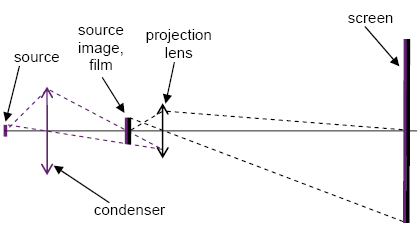Optipedia • SPIE Press books opened for your reference.
Abbe Illumination
Excerpt from Field Guide to Illumination
Abbe illumination is characterized by imaging the source (or imaging an image of the source) directly onto the illuminated area. Since the uniformity of illumination is directly related to the uniformity of source radiance, Abbe illumination requires an extended source of uniform radiance such as a well-controlled arc, a ribbon filament lamp, the output of a clad rod, a frosted bulb, an illuminated diffuser, or the output of an integrating sphere.
The paraxial layout below shows Abbe illumination used in a projection system. The source is imaged by a condenser onto the film. The projection objective images the film and the image of the source onto the screen. The purple dotted lines show the marginal and chief rays from the source. The black dotted lines show the marginal and chief rays from the film (and the image of the source). The marginal rays go through the on-axis points on the object and image and on the edges of the pupils (which are the lenses in this case). The chief rays go through the edges of the object and image and the on-axis points of the pupils.

A. V. Arecchi, T. Messadi, and R. J. Koshel, Field Guide to Illumination, SPIE Press, Bellingham, WA (2007).
View SPIE terms of use.
Non-Member: $42.00

